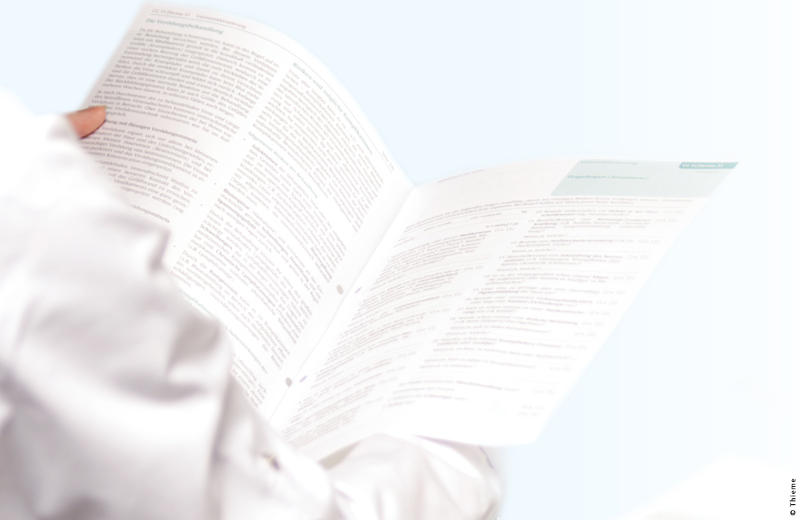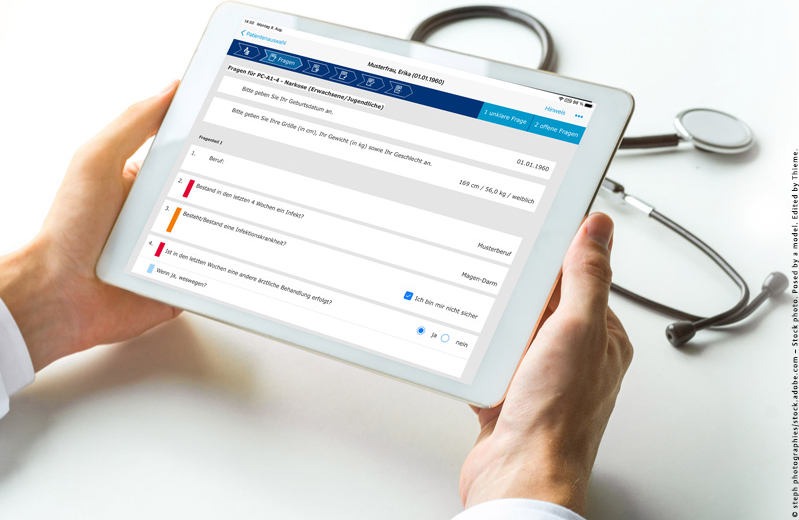About Thieme Compliance GmbH and patient education leaflets
Thieme Compliance GmbH, based in Erlangen, Germany, is a company that specialises in providing patient education solutions for healthcare facilities. These solutions include, among other things, information materials that educate patients about their illnesses, treatment options and possible risks. Patient education is an important aspect of healthcare as it helps patients make informed decisions about their health. It is also an important legal and ethical principle in medicine.
Thieme Compliance GmbH supports healthcare facilities in implementing this principle by providing customised information materials tailored to the specific needs of patients. The materials are developed in close cooperation with more than 400 experts from the medical community and tested for their comprehensibility and usefulness. Furthermore, a team of legal advisors ensures that the patient education content always corresponds to current case law. Professional societies and associations recommend the patient education leaflets from Thieme Compliance. In total, more than 2,000 patient education leaflets from more than 30 speciality areas are available in up to 31 languages. They are available in digital form as well as various print formats.
Figure 1. Patient education leaflet
 |
The aim is to help ensure that patients are better informed and educated so that they can make decisions about their health in close cooperation with their doctors. Clinics and practices are supported in meeting legal requirements and minimising liability risks by using patient education leaflets. Under certain conditions, the clinics and practices can even receive a reduced insurance premium if they use the patient education leaflets from Thieme Compliance GmbH, as the risk of being sued by a patient is reduced.
The educational content is made available to clinics and practices via the self-developed software E-ConsentPro. E-ConsentPro is installed on-premise in clinics and practices and offers interfaces to, or is even embedded in, clinical information systems. It ships with Saxon-EE, Antenna House Formatter, XSLT as well as XSL-FO stylesheets, fonts, etc. and can thus be used to generate various media forms of the patient education leaflets, supplemented and personalised with data from the clinical information system.
Figure 2. “Anamnese mobil” app from E-ConsentPro
 |
For parts of the patient education leaflets, such as the medical history, HL7's FHIR (Fast Healthcare Interoperability Resources) questionnaire resource is used for syntactic healthcare interoperability. The HL7 FHIR standard is based on a RESTful API architecture. This is an emerging standard for exchanging medical data between different systems and institutions and will replace the established HL7 V2 standard in the future. To ensure semantic healthcare interoperability as well, the questionnaire resource contains coding from SNOMED CT (Systematized Nomenclature of Medicine and Clinical Terms) or LOINC (Logical Observation Identifiers Names and Codes):
<fhir:item> <fhir:linkId value="MF_Erkrankungen_Familie__Erkrankung_Blutsverwandtschaft" /> <fhir:text value="Among your blood relatives, are or were there any diseases or indications of a disease?" /> <fhir:type value="open-choice" /> <fhir:required value="true" /> <fhir:repeats value="true" /> <fhir:answerOption id="MF_Erkrankungen_Familie__Erkrankung_Blutsverwandtschaft__nein"> <fhir:extension url="http://hl7.org/fhir/StructureDefinition/questionnaire-optionExclusive"> <fhir:valueBoolean value="true" /> </fhir:extension> <fhir:valueCoding> <fhir:system value="http://snomed.info/sct" /> <fhir:version value="http://snomed.info/sct/900000000000207008/version/20220430" /> <fhir:code value="160266009" /> <fhir:display value="No family history of clinical finding (situation)" /> </fhir:valueCoding> </fhir:answerOption> <fhir:answerOption id="MF_Erkrankungen_Familie__Erkrankung_Blutsverwandtschaft__Krebs"> <fhir:valueCoding> <fhir:system value="http://snomed.info/sct" /> <fhir:version value="http://snomed.info/sct/900000000000207008/version/20210131" /> <fhir:code value="275937001" /> <fhir:display value="Family history of cancer (situation)" /> </fhir:valueCoding> </fhir:answerOption> <!-- ... --> <fhir:answerOption id="MF_Erkrankungen_Familie__Erkrankung_Blutsverwandtschaft__Erbkrankheiten"> <fhir:valueCoding> <fhir:system value="http://snomed.info/sct" /> <fhir:version value="http://snomed.info/sct/900000000000207008/version/20220430" /> <fhir:code value="429962007" /> <fhir:display value="Family history of hereditary disease (situation)" /> </fhir:valueCoding> </fhir:answerOption> </fhir:item>
The patient education content is created and managed using the component content management system Content Lifecycle System (CLS) from Empolis Solutions GmbH. It consists of XML files with single-source-capability, modularised using XInclude. Because of the rich semantics, a self-developed data structure T0 XSD is used.
The patient education leaflets are published in various media formats such as PDF, XHTML, HTML5, WordML, SpreadsheetML, among others. To facilitate the data exchange, especially with partners, the content is converted into a variety of XML dialects as well as JSON formats. Therefore, fully or at least highly automated publishing pipelines are being developed and maintained.